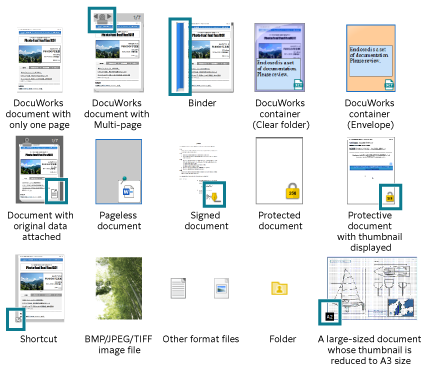Types of Documents Handled in DocuWorks
DocuWorks can handle the following types of documents:
DocuWorks documents
Document data created by DocuWorks. Application data and image files can be converted to create DocuWorks documents.
You can add annotations such as notepads, text, freehand drawings, shapes, date stamps, and received stamps to a DocuWorks document. DocuWorks files have the extension "xdw".
You can add annotations such as notepads, text, freehand drawings, shapes, date stamps, and received stamps to a DocuWorks document. DocuWorks files have the extension "xdw".
DocuWorks binder
A file used for holding a batch of DocuWorks documents together. The extension is "xbd".
DocuWorks container
A file that can be used like an envelopes or "Clear Folder" to store DocuWorks documents, DocuWorks binders, and any other files. Each DocuWorks container can contain further DocuWorks containers. The extension is "xct".
DocuWorks file
A term used to refer collectively to DocuWorks documents, DocuWorks binders, and DocuWorks containers.
Original data
Application data that is attached to DocuWorks documents or DocuWorks binders. Such data can be edited by starting up the parent application from DocuWorks.
Pageless document
A DocuWorks document that does not have any pages. Original data can be attached.
Signed documents
A DocuWorks file that has a signature in the form of a DocuWorks Electronic Signature or a Digital Certificate. You can clarify a person in charge of creation and in charge of approval, and to confirm editing status.
Protected documents
A DocuWorks file for which security settings have been made.
Documents are protected using a password, a DocuWorks Electronic Signature, or a Digital Certificate. Protection places limits on opening or manipulating (document editing, copying, printing, or annotation editing) protected documents and binders.
Documents are protected using a password, a DocuWorks Electronic Signature, or a Digital Certificate. Protection places limits on opening or manipulating (document editing, copying, printing, or annotation editing) protected documents and binders.
Shortcut to a DocuWorks file
A shortcut to a DocuWorks document or a DocuWorks binder. If you configure the settings to display files other than DocuWorks documents, the shortcut appears in thumbnail view. You can display and print such files in the same way as DocuWorks documents.
Files in other formats
Files other than DocuWorks documents and DocuWorks binders such as image files and files created by other applications. You can display such files in the workspace on Desk, and perform file operations including moving the files between folders, or copying or deleting the files, and start the application associated with the files using Windows Explorer. You can also convert the files to DocuWorks documents.
PDF files, image files, Microsoft Word, Microsoft Excel, and Microsoft PowerPoint documents can be displayed as thumbnails.
For the conditions of displaying Microsoft Word, Microsoft Excel, and Microsoft PowerPoint documents in the thumbnail view, refer to "Workspace View Modes".
PDF files, image files, Microsoft Word, Microsoft Excel, and Microsoft PowerPoint documents can be displayed as thumbnails.
For the conditions of displaying Microsoft Word, Microsoft Excel, and Microsoft PowerPoint documents in the thumbnail view, refer to "Workspace View Modes".
Folder
Used to organize and store files. Folders appear in the folders area on Desk. If you configure the settings to display files other than DocuWorks files in the workspace of Desk, subfolders appear as icons in the workspace.
The thumbnails on Desk
Thumbnails for respective files appear on Desk as shown below.

Note
- PDF files protected by security cannot be displayed as thumbnails. They are displayed as icons.
- When Desk starts up for the first time following installation, folders are not displayed. To display folders, specify so in [View] under [DocuWorks Desk Options] in the [Preferences] dialog box.
Thumbnails in Windows Explorer
Thumbnails of the DocuWorks files are displayed in Windows Explorer. Configure the settings as follows to display thumbnails in Windows Explorer.
- Select [Extra Large Icons], [Large Icons], or [Medium Icons] as display preferences.